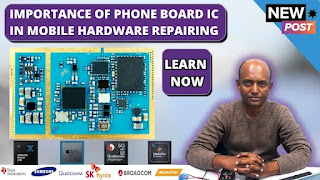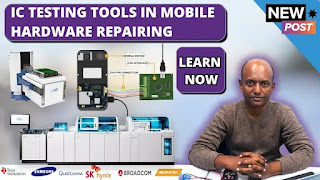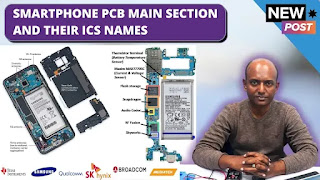What is Phone Board IC
Mobile phone boards are complicated and have many different parts and circuits. One of the most important parts of a phone board is the board IC or integrated circuit. A board IC is a small chip that contains many electronic components inside it and performs a specific function in the phone. For example, there are board ICs for application processor chips, power management chips, baseband processor chips, and so on.
 |
| Phone Board ICs Importance |
A board IC is usually attached to the phone's PCB, or printed circuit board, which is the main framework that links all the components together.
Learn to identify IC used in mobile phones by mobile ic images
IC Testing Tools in Mobile Hardware Repairing
Testing phone board ICs is an important step in mobile hardware repair. A faulty or damaged board IC can cause various problems in a smartphone, such as:
- No power or a dead phone.
- No network or weak signal.
- No sound or distorted sound.
- No display, black screen, or No display backlight.
- No charging.
- No connectivity.
- Software errors.
To test mobile phone board ICs, you need some basic and advanced tools, such as:
- A digital multimeter is a device that can measure current, voltage, resistance, and continuity in smartphone PCB.
- The microscope is a device that can enlarge small objects for better inspection. it helps read the IC brand name and manufacturer code.
- A DC power supply is a device that can measure current, and voltage, on a smartphone battery and PCB.
- An SMD rework station is a device that can heat and remove soldered ICs and components from a smartphone PCB.
- A Tweezer is a tool that can hold small IC and components on the PCB.
- The phone board diagram uses symbols to represent different components and the ICs of the phone. Label the symbols with the names of the components and the ICs they represent. The diagrams are typically used by telecommunications engineers to troubleshoot and repair smartphones.
 |
| Advance tools for testing mobile ics |
These are the basic tools used by every mobile technician. Now let me tell you about the advanced tools used by professional technicians in the mobile company.
- In-circuit tester (ICT): This is a tool that can be used to test the functionality of individual ICs on a motherboard. It does this by applying electrical signals to the IC and then monitoring the output signals.
- Functional test board (FTB): This is a board that contains a variety of ICs that are commonly used in smartphones. It can be used to test the functionality of these ICs by connecting them to a smartphone motherboard.
- Boundary scan test (BST): This is a technique that can be use to test the connections between different ICs on a motherboard. It does this by sending electrical signals through the connections and then monitoring the output signals.
- Pin in wave (PIW): This is a technique that can be used to test the functionality of ICs by applying electrical signals to the pins of the IC in a specific order. This allows the tester to test the IC's functionality more quickly and efficiently.
- JTAG: This is a standard interface that can be used to connect a tester to an IC. It allows the tester to control the IC and to read and write data to the IC's memory.
Smartphone PCB Main Section and Their ICs Names
- Processor.
- Memory.
- Graphics.
 |
| Smartphone PCB Main Section |
- Modem.
- Connectivity.
- Sensor.
- Power Management.
- Audio.
- Camera.
List of Phone Board ICs
Here is the name list of ICs on the smartphone.
- Application Processor Chip.
- Graphics Processing Unit Chip.
- Memory Controller Chip.
- Wi-Fi/Bluetooth Chip.
- Modem Chip.
- Sensor Chip.
- Touch Controller Chip.
- Power Management Chip.
- DC to DC Chip.
- Audio Chip.
- Camera Chip.
You can free download a list of phone board Chip click here.
Steps of Testing IC in Phone Board
 |
| Cell phone ics testing |
The process mobile technication follows to test phone board ICs involves the following steps before he gives you the IC repair cost:
- Disassemble the phone and remove the PCB from the housing.
- Clean the PCB with a CTC and brush to remove any dust or dirt.
- Inspect the PCB visually with a microscope to look for any physical damage, such as cracks, burns, and corrosion.
- Identify the Phone ICs on the PCB by their labels or codes. They research smartphone brands and its model in the online mobile schematics tool for more information.
- They test board IC with a multimeter and DC power supply by measuring its voltage or continuity data sheet. They read the correct values or readings from the smartphone schematic on the online tool.
- If they find any board IC or component that is faulty or damaged, they need to replace it with a new one. To do this, they need to desolder the old board component with a soldering iron and solder the new IC with an SMD rework station. In some cases, they buy a new IC and solder it on the smartphone PCB.
- If they suspect IC is faulty after removing it from the smartphone motherboard they test it separately using an IC tester.
- Then they reassemble the phone and test its functionality.
1 Comments
noormuhammad2490@gmail.com
ReplyDeletePost a Comment
please dont add any spam comment